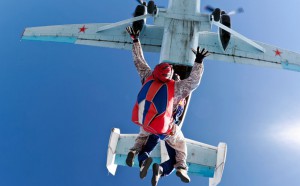The 1970s were a rough decade for skydiving safety. Back when yearly jumps measured in the thousands, around 42 fatal accidents were reported by the United States Parachute Association (USPA) per year. Without a doubt, some changes definitely need to be made. Since then, skydiving safety has been on the rise and accidents have fallen, with the USPA reporting just 15 fatal accidents out of roughly 3.3 million jumps in 2019. Those numbers continue to improve when you look at the risk of tandem skydiving, which has proven itself time and time again as one of the safest methods of jumping.
Everyone is aware that risk comes with the territory in regards to skydiving, but in actuality most accidents result from human error. What steps can be taken to assure a safe experience? Have advances been made in regards to safety when it comes to this extreme sport?
Skydiving Safety and Standards
There has been a lot of overhaul in regards to how first-time jumps are handled. For first-time and less experienced jumpers, listening to your instructor is your number one way to stay safe. An extreme sport is so-called because of how it pushes your physical and mental limits beyond what you previously felt were possible.
They are often dangerous, but thrilling and common bucket-list items for people around the world. Because of this, nearly all extreme sports have specialized equipment. Skydiving is no different, and the equipment needed for this sport has continued to improve and evolve through the years.
What kind of equipment might you come across and how does this equipment ensure a safer jump? A sample includes, but is not limited to:
- The Altimeter. An altimeter is a must-have piece of equipment for all skydivers. This sensitive instrument measures your height above the level of the earth and gives you a spot-on prediction of your falling speed. Your instructor will be in control of this, whether with a digital display hand held instrument or an integrated helmet audio altimeter, and will make sure you are both aware of when to deploy your chute. This allows for optimized free-fall and sailing time.
- The Harness. Often an afterthought for newbies, your harness is incredibly important. The fit and condition are important to holding you to your chute — and to your instructor! Before you get in the air, your harness will be inspected. You will also be properly fitted by staff who will make sure you are safe and snug.
- The Automatic Activation Device (AAD). An AAD is another must-have for proper centers. This device will be calibrated on the ground and rechecked at least once if not twice. This is because an AAD will make sure your chute deploys at the right altitude in case the diver forgets to (or cannot) pull the cord themselves.
Teaching Skydiving Safety Techniques
Equipment is far from where the safety evolution ends for skydiving. Teaching methods and practices have also continued to evolve. Tradition can be a good thing, but you never want tradition to get in the way of safety and progress.
In the past, a diver’s first jump was typically a ‘static-line’ jump. These jumps did not involve any free-fall and occurred from about 4,000ft up. You were not in control of deploying your chute; that was accomplished by the ‘static line’ connecting you to the plane. Once your chute deployed, you were more or less in control of landing as close to the landing zone as possible, very much at the mercy of the wind.
While static-line jumps do still exist, they are not the industry standard for first timers any longer. Tandem is now the preferred technique worldwide for first jumps. Tandem instructors are required to go through classes and training to earn an instructor rating from the USPA. You will be strapped to someone who will help you control your parachute, ensuring a safe landing for you both.
Your instructor is a top factor in your safety when tandem skydiving is involved. In the past when finding an instructor and center to work with, you had to rely on advertising and word of mouth. But thanks to the internet, you can do the research yourself to make sure your instructors meet your standards. The USPA offers an easy-to-navigate listing through their website for both center and instructors. Make sure that both of yours are listed here! Instructors listed with the USPA will have gone through the proper training and received certifications.
You want experts to take care of you!
While there are definitely risks that come along with skydiving safety, the risks present in the modern day are minimal. As long as you are responsible and do your research, you will be able to pick a reputable center that takes care of all of your concerns. A reputable center will have modern equipment, follow standard safety practices, and will be staffed by certified and passionate instructors.
Those instructors will make sure your equipment is in perfect shape before you ever get to the sky. When you do finally get your head in the clouds, you won’t have a single worry. Safely strapped to your instructor and armed with the top tools for the job, you can sit back, relax, and enjoy the view.
Are you ready to take that leap? If so, contact us today. We are happy to help you book a breath-taking experience, whether it is a solo jump or you’re ready to party. Give us a call at 904-718-4648 or email us at skydiveamelia@gmail.com.SkydiveAmeliaIsland.com



